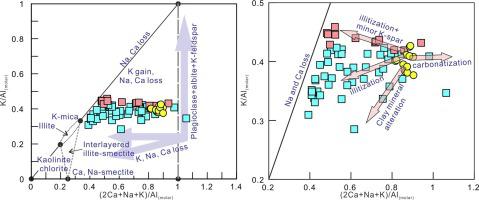当前位置:
X-MOL 学术
›
Ore Geol. Rev.
›
论文详情
Our official English website, www.x-mol.net, welcomes your
feedback! (Note: you will need to create a separate account there.)
Hydrothermal Alteration and Elemental Mass Changes of the Xiangyangping Uranium Deposit in the Miao’ershan Ore Field, South China
Ore Geology Reviews ( IF 3.2 ) Pub Date : 2020-10-01 , DOI: 10.1016/j.oregeorev.2020.103675 Chi-Da Yu , Kai-Xing Wang , Xiao-Dong Liu , Jia-Yong Pan , Qi Chen , Jian Zhang
Ore Geology Reviews ( IF 3.2 ) Pub Date : 2020-10-01 , DOI: 10.1016/j.oregeorev.2020.103675 Chi-Da Yu , Kai-Xing Wang , Xiao-Dong Liu , Jia-Yong Pan , Qi Chen , Jian Zhang

|
Abstract Hydrothermal alteration records the effects of fluid-rock interactions and can therefore be used to constrain metal mineralization. Although hydrothermal alteration is widely developed in the hydrothermal vein-type uranium deposit in South China, consideration of the elemental mass changes during alteration is rare. The Xiangyangping uranium deposit in the Miao’ershan uranium orefield is mainly hosted by the Douzhashan granite in South China. Observations made at this deposit are used to address hydrothermal alterations and their relationship with elemental mass change. The Xiangyangping deposit is characterized by seven types of alteration appearances, including K-feldspathization, K-mica/illitization, silicification, carbonatization, chloritization, pyritization, and hematitization. Based on the field characteristics, the altered samples in the Xiangyangping deposit were divided into the red-altered (type 1) and grey- altered (type 2) zones. Whole-rock geochemistry of the altered samples in this deposit indicated that there are varying element concentrations depending on the different altered zones: (1) the altered samples in type 1 had higher molar K/Al and lower (2Ca + Na + K)/Al ratios and the altered samples in type 2 displayed lower molar K/Al and lower (2Ca + Na + K)/Al ratios than the least-altered host granitoids; (2) the altered samples in type 1 showed Si, K, Al, P, and Rb gains and Na loss, whereas the samples in type 2 showed Si, K, Al, P, Rb, and Na losses. Alteration assessment results revealed that the samples in type 1 experience moderate K-H metasomatism and intensive Si-metasomatism, and the samples in type 2 underwent intensive K-H metasomatism and weak Si-metasomatism. The samples in type 1 were dominated by conversion of plagioclase to K-mica/illite and K-feldspar, while the abundant K-feldspar grains in the samples of type 2 were altered to K-mica/illite.
中文翻译:

庙儿山矿田向阳坪铀矿床热液蚀变及元素质量变化
摘要 热液蚀变记录了流体-岩石相互作用的影响,因此可用于限制金属矿化。华南热液脉型铀矿床虽然广泛发育热液蚀变,但很少考虑蚀变过程中的元素质量变化。庙儿山铀矿田向阳坪铀矿床以华南豆渣山花岗岩为主。在该矿床进行的观测用于解决热液蚀变及其与元素质量变化的关系。向阳坪矿床具有钾长石化、钾云母/伊利石化、硅化、碳酸盐化、绿泥石化、黄铁矿化和赤铁矿化7种蚀变形态特征。根据现场特点,向阳坪矿床蚀变样品分为红色蚀变(1型)和灰色蚀变(2型)带。该矿床蚀变样品的全岩地球化学表明,不同蚀变带存在不同的元素浓度:(1)1型蚀变样品的摩尔K/Al较高,而(2Ca+Na+K)/与变化最小的寄主花岗岩相比,2 型中的 Al 比率和改变的样品显示出较低的 K/Al 摩尔比和较低的 (2Ca + Na + K)/Al 比率;(2) 1型变质样品显示Si、K、Al、P、Rb增加和Na损失,而2型样品显示Si、K、Al、P、Rb和Na损失。改造评估结果显示,1型样品经历中度KH交代和强烈Si交代,2型样品经历了强烈的KH交代和弱Si-交代。1型样品以斜长石转化为钾云母/伊利石和钾长石为主,而2型样品中丰富的钾长石颗粒转变为钾云母/伊利石。
更新日期:2020-10-01
中文翻译:

庙儿山矿田向阳坪铀矿床热液蚀变及元素质量变化
摘要 热液蚀变记录了流体-岩石相互作用的影响,因此可用于限制金属矿化。华南热液脉型铀矿床虽然广泛发育热液蚀变,但很少考虑蚀变过程中的元素质量变化。庙儿山铀矿田向阳坪铀矿床以华南豆渣山花岗岩为主。在该矿床进行的观测用于解决热液蚀变及其与元素质量变化的关系。向阳坪矿床具有钾长石化、钾云母/伊利石化、硅化、碳酸盐化、绿泥石化、黄铁矿化和赤铁矿化7种蚀变形态特征。根据现场特点,向阳坪矿床蚀变样品分为红色蚀变(1型)和灰色蚀变(2型)带。该矿床蚀变样品的全岩地球化学表明,不同蚀变带存在不同的元素浓度:(1)1型蚀变样品的摩尔K/Al较高,而(2Ca+Na+K)/与变化最小的寄主花岗岩相比,2 型中的 Al 比率和改变的样品显示出较低的 K/Al 摩尔比和较低的 (2Ca + Na + K)/Al 比率;(2) 1型变质样品显示Si、K、Al、P、Rb增加和Na损失,而2型样品显示Si、K、Al、P、Rb和Na损失。改造评估结果显示,1型样品经历中度KH交代和强烈Si交代,2型样品经历了强烈的KH交代和弱Si-交代。1型样品以斜长石转化为钾云母/伊利石和钾长石为主,而2型样品中丰富的钾长石颗粒转变为钾云母/伊利石。











































 京公网安备 11010802027423号
京公网安备 11010802027423号